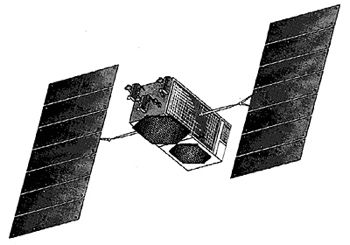
Home - Search - Browse - Alphabetic Index: 0- 1- 2- 3- 4- 5- 6- 7- 8- 9
A- B- C- D- E- F- G- H- I- J- K- L- M- N- O- P- Q- R- S- T- U- V- W- X- Y- Z
Odyssey
 Odyssey Credit: Manufacturer Image |
Status: Cancelled 1997. Gross mass: 1,917 kg (4,226 lb).
The Odyssey satellite network was to have provided global voice, fax, and message communications services to users equipped with portable handsets. The system was being developed as a joint commercial venture (called Odyssey World-wide Services) by TRW and Teleglobe Canada. Operations were planned in 1997 to begin by the end of 1998. However in the event the entire enterprise was cancelled when the dot-com / MEO satellite bubble burst.
TRW estimated that it would cost $1.8 billion to build and launch the 12 satellites planned (with two ground spares), install ground stations in the United States, and operate the system for 1one year. User costs were expected to be $250 - $300 for the cellular phone handset, a $24 monthly charge, and 65 cents/minute use charges and 10 cents/minute access fees. TRW received an FCC license for the system in early 1995. Initial operation was planned by the end of 1998, using the first six satellites giving limited service to selected regions. The full constellation of 12 satellites was planned to be in place by the end of 1999.
The spacecraft was to have rotated in attitude to remain focused on a service region. Solar power was 4600 W at end of life. The satellites would connect the user to a Ka-band ground station, where the call was routed into the normal telephone system. No satellite crosslinks were used in the constellation. Each region would have one ground station equipped with four 5 m antennas.10 - 11 stations were planned world-wide.
Channel capacity of each satellite was to have been 3000 digital voice circuits at 4.8 kbps. The total beam width of 40 deg. provided coverage to regions 7400 km across. The beam was made up of 37 cells, each covering an 1100 km diameter circle. Power distribution allowed up to 25% of total satellite power to be concentrated in one cell, and 75% of the capacity could be focused on 10% of a region. The link margin was 6 to 10 dB. Each satellite had 37 x 25W bent-pipe S-Band transmitters (2486.42, 2491.75 and 2497.06 MHz) with antenna gains of 25-30 dB from a 1.6 m reflector. Handset transmitter power would have been 0.5W with a hemispherical antenna pattern using L-Band uplink (1612.32, 1618.25 and 1623.58 MHz). Each of the 6 channels (3 uplink and 3 downlink) were 5.5 MHz wide. The L-Band signals were received by the spacecraft with a 2.4 m reflector. Signals would have used spread-spectrum CDMA.
At the time of the FCC application on 26 September 1997, total cost was $ 3.4 billion estimated for 19 units of the broad band system, 4 geosynchronous satellites, and 15 medium earth orbit satellites. This was later revised to $ 3.2 billion for 12 units (3 planes x 4 satellites + 6 spares). TRW received a contract for $ 2280 million for 14 satellites in January 1996 including ground equipment, but no launches were booked. The enterprise could not get financing as of 1 September 1997 and was abandoned in 1998.
More at: Odyssey.
Family: Communications, Medium earth orbit. Country: USA. Spacecraft: Odyssey. Agency: TRW, Teleglobe. Bibliography: 6.
Back to top of page
Home - Search - Browse - Alphabetic Index: 0- 1- 2- 3- 4- 5- 6- 7- 8- 9
A- B- C- D- E- F- G- H- I- J- K- L- M- N- O- P- Q- R- S- T- U- V- W- X- Y- Z
© 1997-2019 Mark Wade - Contact
© / Conditions for Use